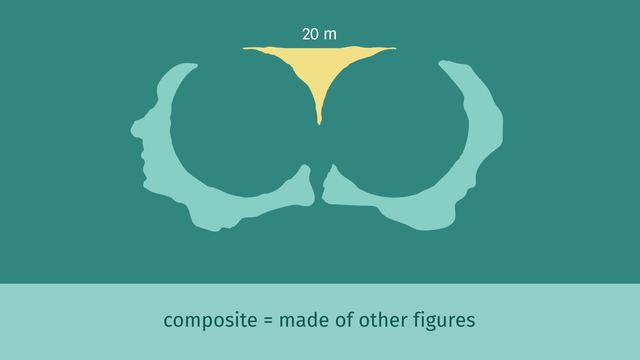Composite Area Problems with Circular Regions


Basics on the topic Composite Area Problems with Circular Regions
After this lesson, you will be able to find the area of composite areas with circular regions.
The lesson begins by teaching you that composite figures can be broken up into smaller regions… often in many different ways! It leads you to learn how to determine the different simpler shapes and then decide if you need to add or substract those shapes.
Learn about decomposing polygons by helping Prince Icarus learn to fly!
This video includes key concepts, notation, and vocabulary such as the terms “composite figure” (a shape composed of smaller shapes); “decomposition” (breaking down a shape into smaller regions”; and “area” (the size of a surface or two-dimensional shape).
Before watching this video, you should already be familiar with the formulas for the areas of circles and rectangles. You should also remember how to use composition and decomposition to find the areas of parallelograms and trapezoids.
After watching this video, you will be prepared to learn how to determine the areas of complex, irregular polygons; and how to determine missing values on a diagram.
Common Core Standard(s) in focus: 6.GA.1 A video intended for math students in the 6th grade Recommended for students who are 11 - 12 years old
Transcript Composite Area Problems with Circular Regions
Incoming! It's a bird, it's a plane, it's...Ankita! She's performing her latest, daring skydive jump! Ankita needs more than 44 square meters of space to land. To make sure she lands safely, we'll help Ankita solve Composite Area Problems with Circular Regions. Ankita wants to land on a small area of a man-made island. The island, pictured here, is a composite figure because it is made up of a few figures. Notice we can see it's composed of circles here and even a rectangle here. To find the area of this top section, we already have all the tools we need. How do you think we could use our knowledge about simple shapes to find the landing area? We can take the area of the rectangle and subtract the area of the circular parts. First, let's find the area of the rectangle. We can see that the length of the rectangle is 20 meters, but what about the width? Since the length is the same as two radii put together, then the radius of each circle must be half of 20 meters, which is 10 meters. The radius of 10 meters is equal to the width of the rectangle. So, we can substitute 20 for length and 10 for width in our area of a rectangle formula. That gives us 200 meters squared. Now that we've found the area of the enclosing shape, our next step is to find the area of the two quarter circles. Both circles have the same radius, so they are the same size! Do you remember the formula for the area of a circle? It's pi times the radius squared. Since we have 2 quarter circles, we actually have a half circle. Therefore, we can multiply our area formula by one-half. Now we just need to substitute 10 for the radius. Evaluating, we find the area of the two quarter-circles combined is 50 pi meters squared When we approximate pi to be 3.14, we get approximately 157.08 meters squared. Okay, last step! To find the area of the landing pad, let's substitute into our equation the area of the rectangle and the area of the circular parts Evaluating gives us an area of approximately 42.92 meters squared. Unfortunately, this doesn't give Ankita more than the 44 square meters she needs to make a clean landing! So, Ankita diverts to the next island! To find the area of this composite figure, what shapes can you identify? There is a triangle and three semicircles. The landing area equals the sum of the areas of these four shapes. Let's start with the triangle. Do you remember the formula for the area of a triangle? That's right, the area is one-half times the base times the height. We can substitute 6 for the base and 4 for the height. Evaluating, we find the area of the triangle is 12 meters squared. Let's substitute that into our overall equation. Now, what about the semicircles? Notice that there are two semicircles with the same diameter of 5 meters. In fact, put together, they make one complete circle. Therefore, we can find the area by simply using the area formula for a circle, 'A' equals pi 'r' squared. Recall that the radius is half the diameter, so in this case 2.5 meters. Approximating 3.14 for pi and evaluating gives us the area of these two semicircles to be approximately 19.63 meters squared. Let's substitute that solution into our formula. Now for the final semicircle with a diameter of 6 meters. We need to calculate one-half pi 'r' squared. Substituting half of the value of the diameter, 3, for the radius and evaluating gives us approximately 14.14 meters squared. Let's substitute that into our landing area equation. We've calculated the area of each piece, so we just need to sum them up to find the total area. The total area of the landing pad is approximately 45.77 square meters. This is greater than 44 square meters, so Ankita should have no problem landing here. Let's review our methods for calculating Ankita's perfect landings! To calculate the areas of composite figures with circular regions, first, identify simpler shapes that compose or enclose the figure. Then, determine if you'll need to add together or subtract out certain shapes to form the total area. Finally, substitute and evaluate the area with the deminsions you have. Ankita is coming in for her landing.











